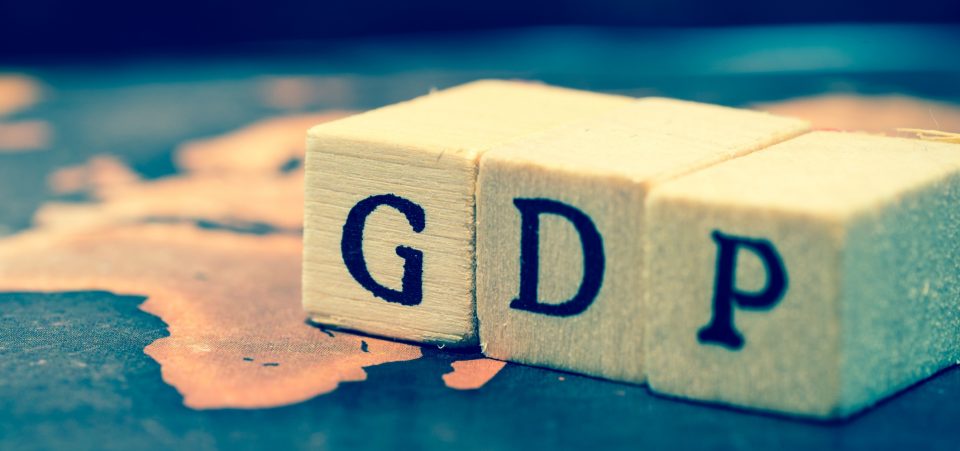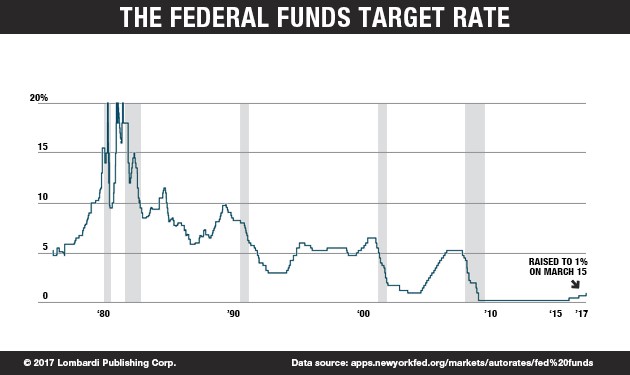Why on Earth Did the Fed Raise Rates in March?
For the second time in three months and just the third time in a decade, the Federal Reserve raised its key lending rate a quarter of a point to a range of 0.75% to 1.0%. Moreover, the Fed hinted it could raise rates two more times in 2017. But one has to wonder why the Fed would raise rates when gross domestic product (GDP) has been anemic. And according to one Federal Reserve Bank, U.S. GDP will grind down in 2017. That could undermine the already shaky U.S. economy and put an end to the second-longest bull market in history.
On March 15, Federal Reserve Chair Janet Yellen raised the Feds key lending rate for just the third time in ten years amid rising confidence that the U.S. economy is on solid ground and poised for sustained economic growth. The Fed forecasts 2017 GDP to remain at 2.1% while GDP growth in 2018 was increased one-tenth to 2.1%. (Source: “Fed Raises Rates; Yellen Holds Press Conference — Live Analysis,” The Wall Street Journal, March 15, 2017.)
Also Read: U.S. Economic Outlook 2017: Trigger Event Could Rock U.S. Economy
Fast growth indeed! But it’s not. Not by a long shot. Let’s review the recent GDP growth from the world’s largest economy
Under President Barack Obama (January 20, 2009 to January 20, 2017), GDP averaged just 2.3% and was a paltry 1.6% in his last year in office. In the fourth quarter of 2016, GDP slowed to 1.9%.
As a result of decent February jobs data and inflation closing in on two percent, the Fed believes the U.S. economy is speeding up and expects GDP to grow by 2.1% in 2017. Which to some, is seen as achievable.
The New York Federal Reserve raised its estimated for first-quarter GDP to grow at a blistering annualized pace of 3.2% and for second-quarter GDP to hit 3.0%. These forecasts represent a 0.1% increase from previous guidance. (Source: “Nowcasting Report,” Federal Reserve Bank of New York, March 10, 2017.)
| Year | GDP Growth Rate |
| 2008 | -0.3% |
| 2009 | -2.8% |
| 2010 | 2.5% |
| 2011 | 1.6% |
| 2012 | 2.2% |
| 2013 | 1.7% |
| 2014 | 2.4% |
| 2015 | 2.6% |
| 2016 | 1.6% |
But not everyone agrees that happy days are here again. The Atlanta Fed believes that the U.S. economy will advance at its slowest pace in two years. According to the most current data (March 16) first-quarter real GDP growth will be just 0.9%; that’s down from 1.2% (March 8), and down from 2.7% in early February. Where the New York Fed sees the U.S. economic data as being encouraging the Atlanta Fed says the opposite. (Source: “GDPNow,” Federal Reserve Bank of Atlanta, March 16, 2017.)
Did the Fed Just Say It Was Going to Raise Rates Faster?
Raising rates is supposed to moderate the so-called growth that the U.S. economy is enjoying. But one has to wonder why the Fed would want to moderate anemic growth with barely-there wage growth.
Rising rates might be good for savers but it’s going to be killer for those saddled with credit card debt, home equity lines of credit, and adjustable-rate mortgages. The cost of borrowing is going up, and those with variable rate credit will need to pay down their debt as quickly as possible. But that’s going to be tough.
Also Read: U.S. GDP Rate Forecast Predicts Dire Recession in 2017
U.S. households added $226.0 billion in debt during the fourth quarter of 2016. Credit card balances climbed 4.3%, the largest increase for any type of debt. Now, more than half of Americans (56%) have credit card debt of $15,000 or more. Just four percent of U.S. households say they are debt-free. (Source: “Household Debt and Credit Report (Q4, 2016),” Federal Reserve Bank of New York, February 16, 2017.)
Even the eternal optimists at the New York Federal Reserve are sounding the alarm. It projects that by the end of 2017, total household debt will reach the previous record set in 2007. That was just before the housing market collapse and financial crisis rocked the U.S. and global economy. (Source: “Quarterly Report on Household Debt and Credit,” Federal Reserve Bank of New York, February 2017.)
Again, if the U.S. economy was churning out well-paying, secure jobs, maybe it could reach Donald Trump’s campaign target of annual GDP growth of four percent. But that’s going to be a Herculean task. Or more aptly, Sisyphean.
Save for February’s decent jobs report, the U.S. economy has, since the financial crisis, been responsible for creating low-paying, part-time jobs with no wage growth. Unemployment may have fallen to 4.7%, but that’s due in part to a large number of people leaving the workforce after not finding a job. It also doesn’t take into account the fact the underemployment rate is closing in on 10% again.
Against this glacial backdrop, the Federal Reserve suggested, in its March minutes, that it might actually increase the rate hikes in 2017. Not the frequency; the market expects the next Fed hikes to come in June and December. The actual rate.
In its December minutes, the Fed said, “The Committee expects that economic conditions will evolve in a manner that will warrant only gradual increases in the federal funds rate.” [Emphasis added.]
In March, it left out the word “only.” (Source: “Minutes of the Federal Open Market Committee December 13-14, 2016,” Board of Governors of the Federal Reserve System, January 4, 2016.)
Adding and subtracting words from a FOMC speech should not be taken lightly. What could the omission mean? In addition to a hawkish sign, it could mean the Fed is leaving itself room to hike rates more quickly and or to get more aggressive to stay ahead of inflation.
The first is almost a given. As for the second, Donald Trump’s promise to increase government spending, cut taxes, and introduce tariffs, will add to inflationary forces. If Trump manages to introduce his policies, the Fed might struggle holding onto “only” gradual rate increases.
Also Read: 5 Signs of a U.S. Economic Collapse in 2017
Premature Increases Could Cobble U.S. Economic Growth
Raising rates prematurely could seriously undermine U.S. economic growth and put an end to the bull market.
In December, 2015, the Fed raised its rate for the first time in a decade. The markets didn’t think the U.S. economy was ready and stocks tanked. In December 2016, the Fed raised rates again, but investors and consumer optimism is so high that everyone is willing to overlook the fact that nothing has changed since Trump took office. But that courtesy will only last for so long.
Back in 2007/2008, the Fed raised rates prematurely and it helped bring the markets to its knees. It also helped send gold and silver prices soaring. The fact is, the U.S. economy is very weak. Americans can’t find decent jobs, wage growth is virtually non-existent, household debt levels are approaching record levels, and savings are depleted.
Premature rate hikes in 2017 and 2018 could bring the already sluggish U.S. economy to a standstill, which would bring the long-in-the-tooth and significantly overvalued bull market, to a well-deserved end.
Also Read: The Upcoming Economic Recession in 2017 Has Already Begun







